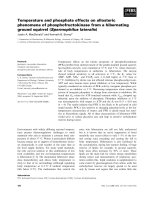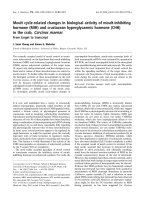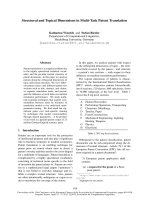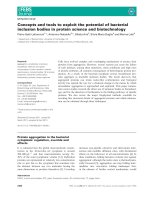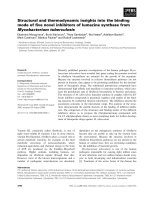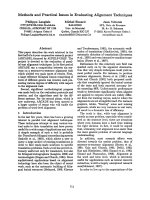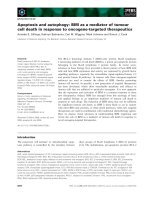Báo cáo khoa học: "Glutamate and GABA concentrations in the cerebellum of novel ataxic mutant Pogo mice" pdf
Bạn đang xem bản rút gọn của tài liệu. Xem và tải ngay bản đầy đủ của tài liệu tại đây (295.91 KB, 4 trang )
-2851$/ 2)
9H W H U L Q D U \
6FLHQFH
J. Vet. Sci.
(2003),
/
4
(3), 209–212
Glutamate and GABA concentrations in the cerebellum of
novel ataxic mutant
Pogo
mice
Ki-Hyung Kim, Jeoung-Hee Ha
1
, Seung-Hyuk Chung, Chul-Tae Kim, Sun-Kyung Kim,
Byung-Hwa Hyun
2
, Kazuhiko Sawada
3
, Yoshihiro Fukui
3
, Il-Kwon Park
4
, Geun-jwa Lee
5
,
Bum-Kyeong Kim, Nam-Seob Lee and Young-Gil Jeong*
Department of Anatomy & Pathology, College of Medicine, Konyang Univiversity, Nonsan 320-711, Korea
1
Department of Pharmacology, College of Medicine, Yeungnam University, Gyeongsan 712-749, Korea
2
Genetic Resource Center, KRIBB, Daejon 305-333, Korea
3
Department of Anatomy, University of Tokushima School of Medicine, Tokushima, Japan
4
Angio-Lab., Paichai University RRC, Daejeon 302-161, Korea
5
Chungnam Livestock & Veterinary Service institute, Hongsung 350-821, Korea
The
Pogo
mouse is an autosomal recessive ataxic mutant
that arose spontaneously in the inbred
KJR/MsKist
strain
derived originally from Korean wild mice. The ataxic
phenotype is characterized by difficulty in maintaining
posture and side to side stability, faulty coordination
between limbs and trunk, and the consequent inability to
walk straight. In the present study, the cerebellar
concentrations of glutamate and GABA were analyzed,
since glutamate is a most prevalent excitatory
neurotransmitter whereas
γ
-aminobutyric acid (GABA) is
one of the most abundant inhibitory neurotransmitters,
which may be the main neurotransmitters related with the
ataxia and epilepsy. The concentration of glutamate of
cerebellum decreased significantly in ataxic mutant
Pogo
mouse compared to those of control mouse. However,
GABA concentration was not decrease. These results
suggested that the decrease in glutamate concentration
may contribute to ataxia in mutant
Pogo
mouse.
Key words:
Pogo
, glutamate, GABA, cerebellum
Introduction
The
Pogo
mouse is an autosomal recessive ataxic mutant
that arose spontaneously in the inbred
KJR/MsKist
strain
derived originally from Korean wild mice. The ataxic
phenotype is characterized by difficulty in maintaining
posture and side to side stability, faulty coordination
between limbs and trunk, and the consequent inability to
walk straight [16,18]. The
Pogo
mutation is inherited as a
trait on chromosome 8 as well as the tottering, leaner, and
rolling mutations.
Glutamate is the most prevalent excitatory
neurotransmitter [6], whereas
γ
-aminobutyric acid
(GABA) is the most abundant inhibitory neurotransmitter
[20]. Glutamate is the main excitatory neurotransmitter in
the brain [10] and all glutamate is formed from glucose
within the central nervous system because glutamate dose
not readily cross the blood-brain barrier [11,15,21,25].
Glutamate is synthesized from 2-oxoglutarate by
transmination either with alanine, aspartate or one of the
branched chain amino acids leucine, isoleucine and valine,
and can also be formed from glutamine by phosphate-
activated glutaminase [28]. Glutamate is accumulated into
vesicles to a high concentration and released to the
synapses by calcium-dependent exocytosis upon the arrival
of an action potential. As a high extracellular concentration
of glutamate is also neurotoxic, high-affinity glutamate
transporters are essential for terminating synaptic
transmission and for maintaining a low extracellular
glutamate concentration.
GABA is the primary inhibitory neurotransmitter known
to counterbalance the action of the excitatory
neurotransmitter glutamate. The importance of GABA as
an inhibitory neurotransmitter in the mammalian
cerebellum is well documented [23,27]. The excitatory
granule cells, by far the most numerous neuronal type in
the cerebellum [9], receive input from GABAergic cells;
thus it has been suggested that the majority of GABA
receptors are located on granule cells [24]. GABA is
thought to be released from the interneurons by
feedforward inhibition from the granule cells or by
feedback inhibition from the pyramidal cells controlled by
*Corresponding author
Phone: +82-41-730-5115; Fax: +82-41-736-5318
E-mail:
210 Ki-Hyung Kim
et al.
glutamatergic nerve endings [12]. The present study
examined that the concentrations of glutamate and GABA
in the cerebellum of
Pogo
mouse.
Materials and Methods
Animals
Mice were generated from a breeding colony of
Pogo
mice developed from original breeding pairs obtained from
Korea Rearch Institute Bioscience and Biotechnology
(KRIBB). 30-day-old ataxic
Pogo
(
pogo
/
pogo
) and normal
wild mice (+/+, control) were used in all experiments. All
experimental procedures were carried out in accordance
with the NIH Guidelines for the Care and Use of
Laboratory Animals.
Immunohistochemistry
All mice were deeply anaesthetized with sodium
pentobarbital (60 mg/kg body weight) and transcardially
perfused with 0.9% NaCl in 0.1 M phosphate buffer saline
(PBS, pH 7.4) followed by 150 ml of 4%
paraformaldehyde in 0.1 M PBS (pH 7.4). These brains
were the removed from the skull and placed immediately
in the same fixative at 4
o
C for 24 hours. The post-fixed
brains were transferred to 0.1 M PBS, and after the brains
were cryoprotected in 10%, 20% and 30% sucrose in 0.1
M PBS and cryostat sectioned in the frontal plane 20
µ
m
thickness. After several rinses in 0.1 M PBS (pH 7.4) the
sections were quenched for 10 min in 1% H
2
O
2
, and rinsed
in 0.1 M Tris phosphate-buffered saline (TPBS; 8.5 mM
Na
2
HPO
4
7H
2
O, 3 mM KH
2
PO
4
, 125 mM NaCl, 30 mM
Tris-HCl, 0.03 mM NaN
3
, pH 7.7). Sections were
incubated overnight at room temperature in rabbit
polyclonal anti-calbindin-D (anti-CaBP, Sigma Inc., St.
Louis MO). They were then washed three times for 5 min
in 0.1 M TPBS, and incubated in 1 : 100 peroxidase-
conjugated anti-rabbit IgG (Dakopatts Inc., Mississauga,
Canada) for 2 hours at room temperature. After three
additional rinses in TPBS, antibody-binding sites were
revealed by a 15 min incubation in 0.2% diaminobenzidine
in TPBS. Sections were then dehydrated though graded
alcohols and mounted in DPX (BDH Chemicals Inc.,
Toronto, Canada).
Determination of glutamate/ GABA levels
Concentarations of glutamate and GABA in the
cerebellums were measured using a modified method of
Allen
et al.
[1]. Tissues were homogenized in 0.3 M
triethanolamine buffer, pH 6.8, containing of 1 mM
aminoetylisothiouronium bromide and 2 mM pyridoxal 5
'
-
phosphate, then centrifuged (Hanil Supra 22K, ROK) at
15,000 g for 20 mins. Postmitochondrial fraction from
each extract was resuspened in 20 mM potassium
phosphate buffer, deproteinizied, and then centrifuged.
Supernatants were filtered by membrane filter (0.2
µ
m:
13 mm), and then o-phtalaldhyde derivatives were used for
the detection of fluorescence in the HPLC measurement
(fluorescence detector, SHIMADZU, Japan, Table 1). The
amounts of glutamate and GABA in cerebellums were
represented as nmole per mg protein.
Results
A. Immunohistochemistry
Calbindin is expressed in the cerebellum exclusively by
Purkinje cells [8,22]. Anti-CaBP immunohistochemistry
deposited peroxidase reaction product throughout all
Purkinje cells, including the somata, dendrites, dendritic
spines and axons, in both normal wild type and
pogo
/
pogo
Table 1. Condition of HPLC for the determination of brain
glutamate and GABA concentration in mice
Parameter Conditions
Column RP-C
18
(150 × 4.0 mm I.D., 10 µm)
Flow rate 0.6 ml/min
Mobile phase
10 mM potassium acetate buffer
(pH 6.5)-methanol
Gradient Methanol 20-70%/40 min
Attenuation 10
Detector Fluorescence detector
(λ
ex
: 340 nm, λ
em
: 450 nm)
F
ig. 1. Anti-calbindin immunoreaction were showed in frontal sections through the vermis of the cerebellum of a +/+ normal wild ty
pe
m
ouse [control] (A) and ataxic
Pogo
mouse [
pogo
/
pogo
homozygote] (B) in lobule VIII and IX. The loss of Purkinje cells (arrow)
in
a
taxic
Pogo
mouse is seen when compared with corresponding lobule of the +/+ normal wild type mouse. Scale bar = 100 µm.
Glutamate and GABA concentrations in the cerebellum of novel ataxic mutant
Pogo
mice 211
mutant mice (Fig. 1). The Purkinje cells appeared normal
in
pogo
/
pogo
mutant mice with respect to their size and
arrangement as a monolayer in the Purkinje cell layer (Fig.
1). Purkinje cell ectopia was rare. Individual Purkinje cells
in the vermis of
pogo
/
pogo
mutant mice are grossly normal
with parasagittaly oriented dendritic arbors extending to
the surface of the molecular layer (Fig 1A). However, in
pogo
/
pogo
mutant mice there was a loss of Purkinje cells
throughout the cerebellar vermis (Fig. 1B). The loss of
somata and dendrites of Purkinje cells was clearly
demonstrated by using anti-CaBP immunostaining (Fig.
1B).
B. Concentration of glutamate and GABA of cerebellum
As illustrated in Table 2 and Fig. 2 the concentration of
glutamate of cerebellum decreased significantly in ataxic
mutant
Pogo
/
Pogo
mouse compared to those of control
mouse. But GABA concentration was not decrease.
Discussion
In our present experiment, the concentration of
glutamate decreased in
pogo
/
pogo
mouse. There have been
several reports of glutamate and GABA concentration in
weaver, Purkinje cell degeneration (PCD), leaner and E1
mouse cerebellum. In weaver mice cerebellum, neuronal
loss occurs during postnatal development and leads to a
partial Purkinje cell degeneration, an almost complete loss
of granule cells and their parallel fibers and, in
consequence, to the formation of ‘heterologous’ mossy
fiber contacts on Purkinje cells and a persistent multi-
innervation of Purkinje cells by olivary climbing fibers
[7,26]. The phase relationships to sinusoidal vestibular
stimulation of floccular Purkinje cells are greatly distorted
and irregular under these conditions making a precise time
matching of convergent input onto target neurons in the
vestibular nuclei highly uncertain [13,14]. In addition,
sprouting and enlargement of GABAergic synaptic
boutons in the dorsal part of the lateral vestibular nuclei
was observerd recently in this mutant [2,3]. In Purkinje cell
degeneration mutants, where cell loss affects the mature
cerebellum, a clear increase in somatal parvalbumin-
immunoreactivity in the vestibular nuclei and deep
cerebellar nuclei suggests an enhanced activity of mainly
inhibitory neurons. However, GABAergic reinnervation
was not found [2,4,5]. In leaner, reinnervative reactions of
both Purkinje cell GABAergic and extracerebellar
GABAergic sources, that would substitute for the lost
Purkinje cell-input, are not indicated by the present
findings using GABA-immunohistochemistry. GABAergic
innervation density is diminished to one-half in the dorsal
part of the lateral vestibular nuclei of leaner, which is only
slightly higher than in Purkinje cell degeneration mutants
[2]. This reduction corresponds well with the massive
Purkinje cell loss in the anterior lobe and shows that, in
contrast to weaver, GABAgergic reinnervation does not
occur under these conditions. In addition, GABAergic
terminals in leaner are reduced in size to such a degree,
comparatively only with that found after experimental
removal of the cerebellum or in Purkinje cell degeneration
mutants [2].
Then, there is a report of the glutamate concentration in
E1 mouse. The E1 mouse is a genetically susceptible
model of complex-partial epilepsy with secondary
generalization of seizures. This model shows elevated
GABA (40-50%) and lowered glutamine and glutamate
(30%) in its most epileptic state E1 (+) compared with
control or E1 (
−
) mice (i.e. same genetic type but not
multiply stimulated to become responded to handling by
having seizures). However, there was a great increase in
glutamate level during the pre-convulsive state, and the
seizures themselves were blocked by AP5 given
intraventricularly 30 mins before seizure induction, in
which GABA levels increased transitorily immediately
after seizures [19]. Thus both glutamatergic and
GABAergic systems appear to be central to the
mechanisms generating seizures in the E1 mouse [17].
In this study, we have provided that the concentration of
glutamate in
pogo
/
pogo
mouse cerebellum decreased
compared to control mouse. However, GABA
concentration was not changed.
These results suggested that the reduction of glutamate
Table 2.
Concentrations of glutamate and GABA in cerebellums
Glutamate (µmol/g) GABA (µmol/g)
Control 11.327 ± 1.561 1.353 ± 0.055
Pogo
9.147 ± 1.457* 1.360 ± 0.074
*Data are represented as Mean
±
S.D. of 6-9 animals. *
p
<0.05:
Significantly different from control
F
ig. 2.
Concentrations of glutamate and GABA in t
he
c
erebellums of control and ataxic
Pogo
(
pogo
/
pogo
) mice.
212 Ki-Hyung Kim
et al.
concentration may related with disarrangement in synapse
and contribute to motor ataxia in
Pogo
mouse.
Acknowledgments
This work was supported by grant No. R05-2002-000-
00710-0 from Basic Research Program of the Korea
Science & Engineering Foundation.
Referneces
1. Allen, I. C. and Griffthis, R. Reversed-phase high
performance liquid chromatographic method for
determination of brain glutamate decarboxylase suitable for
use in kinetic studies. J. Chromatography 1984, 336, 385-
391.
2. Bäurle, J., Grover, B. G. and Grüsser-Cornehls, U.
Plasticity of GABAergic terminals in Deiters nucleus of
weaver mutant and normal mice: a quantitative light
microscopics study. Brain Res. 1992, 591, 305-318.
3. Bäurle, J., and Grüsser-Cornehls, U. Calbindin D-28K in
the lateral vestibular nucleus of mutant mice as a tool to
reveal Purkinje cell plasticity, Neurosci. Lett. 1994, 167, 85-
88.
4. Bäurle, J. and Grüsser-Cornehls, U. (ed), A possible
mechanism to compensate for the loss of cerebellar inhibition
in Purkinje cell degeneration mutant mice. In N. Flsner and
H. Breer (Dds.), Proceeding of 22nd Gottingen Neurobiology
Conference. Vol. 2, p. 409, Georg Thieme, Stuttgart/New
York. 1994.
5. Bäurle, J., Oestreicher, A. B., Gispen, W. H. and Grüsser-
Cornehls, U. Lesion-specific pattern of immuno-
cytochemical distribution of B-50 (GAP-43) in the
cerebellum of weaver and pcd mutant mice: Lack of B-50
involvment in neuroplasticity of Purkinje cell terminals, J.
Neurosci. Res.1994, 38, 327-335.
6. Cotman, C. W., Foster, A. C. and Lanhorn, T. An overview
of glutmate as a neurotransmitter. Adv. Biochem.
Psychopharmacol. 1981, 27, 1-27.
7. Crepel, F. and Mariani, J. Multiple innervation of Purkinje
cells by climbing fibers in the cerebellum of the weaver
mutant mouse. J. Neurobiol. 1976, 7, 579-582.
8. De Camilli, P., Miller, P. E., Levitt, P., Walter, U. and
Greengard, P. Anatomy of cerebellar Purkinje cells in the rat
determined by a specific immunohistochemical marker,
Neuroscience 1984, 11, 761-817.
9. Eccles, J. C., Ito, M. and Sentagothai, J. (ed), The
cerebellum as a neuronal machine, pp. 11-16, Springer, New
York. 1967.
10. Fonnum F. Glutamate: a neurotransmitter in mammalian
brain. J. Neurochem. 1984, 42, 1-11.
11. Gruetter, R., Novotny, E. J., Boulware, S. D., Mason, G.
F., Rothman, D. L., Shulman, G. I., Prichard, J. W. and
Shulman, R. G. Localized
13
C NMR spectroscopy in the
human brain of amino acid labeling from D-[1
13
C]glucose. J.
Neurochem. 1994, 63, 1377-1385.
12. Grudt, T. J. and Jahr, C. E. Quisqualate activates N-methyl-
D-aspartate receptor channels in hippocampal neurons
maintained in culture. Mol. Pharmacol. 1990, 37, 477-481.
13. Grüsser-Cornehls, U. Responses of vestibular neurons from
the nucleus vestibularis and the flocculus in wild type mice
and mutants. Soc. Neurosci. Abstr. 1983, 9, 524.
14. Grüsser-Cornehls, U. (ed), Compensatory mechanisms at
the level of the vestibular nuclei following post-natal
degeneration of specific cerebellar cell classes and ablation
of the cerebellum in mutant mice. In H. Flohr, Post-lesion
Neural Plasticity, pp. 431-442, Springer, Berlin/Heidelberg.
1988.
15. Hawkins, R. A., DeJosepf, M. R. and Hawkins, P. A.
Regional brain glutamate transport in rats at normal and
raised concentrations of circulating glutamate. Cell Tissue
Res. 1995, 281, 207-214.
16. Hyun, B. H., Kim, M. S., Choi, Y. K., Yoon, W. K., Suh, J.
G., Jeong, Y. G., Park, S. K. and Lee, C. H. Mapping of the
Pogo
gene, a new ataxic mutant from Korean wild mice, on
central mouse chromosome 8, Mamm. Genome 2001, 12,
250-252.
17. Janjua, N., Hiramatsu. M., Kabuto, H. and Mori, A.
Glutamic acid and gama-aminobutyric acid in the
biochemical and genetic mechanisms of E1 mouse epilepsy.
Neurosciences 1992, 18 (Suppl. 2), 43-47.
18. Jeong, Y. G., Hyun, B. H. and Hawkes, R. Abnormalities in
cerebellar Purkinje cells in the novel ataxic mutant mouse,
Pogo. Dev. Brain Res. 2000, 125, 61-67.
19. Mori, A. E1 Mice: Neurochemical approach to the seizure
mechanism. Neuroscience 1998, 14, 275-285.
20. Olsen, R. W. and DeLorey, T. M. (ed), GABA and glycine.
In: Siegel, G.J., Agranoff, B. W., Albers, R.W., Fisher, S.K.,
Uhler, M.D., Basic Neurochemisty. pp. 335-346, Lipincott
Williams and Wilkins, Philadelphia. 1999.
21. Oldendorf, W. H. Brain uptake of radiolabeled amino acids,
amines and hexoses after arterial injection. Am. J. Physiol.
1971, 221, 1629-1635.
22. Ozol, K., Hayden, J. M., Oberdick, J. and Hawkes, R.
Transverse zones in the vermis of the mouse cerebellum, J.
Comp. Neurol. 1999, 412, 95-111.
23. Roberts, F., Chase, T. N. and Tower, D. B. (ed), GABA in
nervous system function, pp. 9-13, Raven, New york. 1976.
24. Simantov, R., Oster-Granite, M. L., Nerndon, R. M. and
Snyder, S. H. Gamma-aminobutyric acid (GABA) receptor
binding selectively depleted by viral induced granule cell loss
in hamster cerebellum. Brain Res. 1976, 105, 365-371.
25. Smith, Q. R., Momma, S., Aoyagi, M. and Rapoport, S. I.
Kinetics of neutral amino acid transport across the across the
blood-brain barrier. J. Neurochem. 1987, 49, 1651-1658.
26. Sotelo, C. Dendritic abnormalities of Purkinje cells in
cerebellum of neurological mutant mice (weaver and
staggerer). Adv. Neurol. 1975, 12, 335-351.
27. Tebecis, A. K. Transmitters and identified neurons in the
mammalian central nervous system. pp. 86-115,
Scientichnica. Bristol. 1974.
28. Yudkoff, M. Brain metabolism of branched-chain amino
acids. Glia 1997, 21, 92-98.


